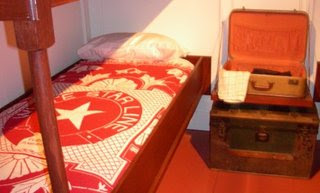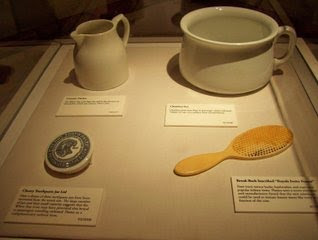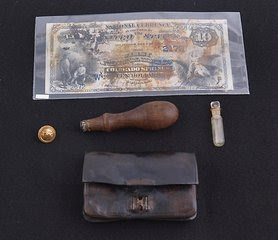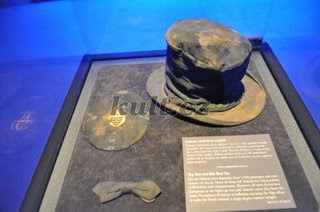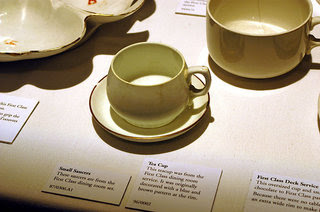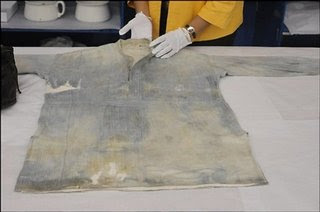>Today, in honor of the 98th anniversary of the sinking of the Titanic, I’m lifting a blog from my old website about my visit to the Georgia Aquarium in 2009. There was a special exhibition that summer of artifacts from the Titanic wreck site. Here is what I experienced.
Saturday was one of those amazing days that teaches you what’s really important as far as being around people who really understand you and accept you unconditionally. Michael and I spent the day with our friend from high school, Lindsey, and her husband, Paul, who I hadn’t met before but turned out to be exceptionally awesome.
Our plan was to go to Gladys Knight Chicken and Waffles to eat lunch and then go to the Georgia Aquarium for the afternoon, but when we got to downtown Atlanta, we realized the parking garage was too far of a walk from the chicken and waffles place. Lindsey is seven months pregnant, so I kind of eye her like a ticking time bomb. We ended up cutting through the park by the CNN building to go to Ted Turner’s restaurant. I think it’s called Montana or something. They serve bison instead of beef there and apparently bison is supposed to be healthier for you. I ate bison pot roast, which was shockingly good. It only tasted a tiny bit different than beef.
After lunch, we cut back through the park and walked to the Georgia Aquarium, slower since we were full from eating so much. I was pretty surprised at how crowded the aquarium was because I had read in the Atlanta Journal-Constitution that attendance had dropped by 37% since it opened in 2005. You would never know it by the lines on Saturday to get tickets. Most of the tickets for the Titanic exhibit were sold out so we had to wait an hour and a half just to get into it. We were going to do the Titanic exhibit first and the regular aquarium afterward but we didn’t count on the Titanic exhibit being so popular. I do love this aquarium with or without special exhibits. It’s the biggest one in the world with animals like four whale sharks (which average at about 30 feet each) and three beluga whales (about 15 feet each). I have a special attachment to Nico (pronounced like Jon Knight’s Nikko), which is the male beluga whale, because he plays with us at the window the most. I had very high aspirations of being a marine biologist throughout my childhood and the first book I ever wrote was a guide to whales and dolphins. I’ve been to this aquarium enough now that I could probably give a tour on my own.
The Titanic exhibit itself was stunning, by every meaning of the word. The only fault I found with it was how crowded it was. They had us crammed in there like sardines so I didn’t get to have a close look at every display. I understand how popular it is and how they have to try to get to everyone but cramming so many people into it might be a little dangerous for the artifacts if somebody bumps into a display too hard or whatever.
Before we went into the exhibit, aquarium workers handed out faux tickets for the ship. We were each given a different passenger with a little biographical information and at the end of the tour, we were to find out if our passenger was a survivor or victim. I was given a second class passenger by the name of Mrs. Irene Corbett and this is what I found about her on the internet:
Mrs Walter H. Corbett (Irene Colvin) was born in 1881/1882, the daughter of Bishop and Mrs Levi A. Colvin of Provo, Utah. Irene was married to Walter Corbett and had three children. She had travelled to London in the winter of 1911-1912 to study nursing while her children stayed with her parents.
Irene’s parents received a letter from her on April 15th in which she said she would take passage on the Titanic. She said several Mormon elders were taking passage on the ship, however it was later uncertain as to whether these elders had actually travelled on the ship. Irene Corbett boarded the Titanic in Southampton.
After the sinking, Bishop Colvin telegraphed New York to find out what had happened to his daughter. He received in answer two telegrams on the afternoon of April 19th. The first stated: “New York, April 19, Levi Colvin, Provo, Utah. Neither the name of Mrs Irene Corbett nor anything like it appears on the Titanic’s second cabin list of passengers as having sailed from Southampton. WHITE STAR LINE.” Minutes later the second telegram arrived: “New York, April 19, Levi Colvin, Provo, Utah. Now find name of Mrs Irene C. Corbett is on the list of passengers having sailed from Southampton, but regret is not a survivor on Carpathia. WHITE STAR LINE.”
Irene Corbett was one of 14 second class women who perished in the sinking.
The exhibit took you through the conception of Titanic, into building it, through the journey to New York, the sinking and the rediscovery of the wreckage by Robert Ballard in the 1980s. There were replica cabins set up with some real artifacts in them to show you what first class and third class were like. I read that the cost of a first class suite would be the equivalent of something like $40,000+ today and a third class cabin that you shared with four other people would be the equivalent of something like $400 today. It was especially interesting to enter the corridor built to replicate the third class corridor because you could feel how cramped it was and how starkly bare it was compared to first class. The replicated third class had ambient noise like what you would have heard and felt being so close to the ship engines and it was loud enough that children on the tour were getting scared and asking what the noise was. It was an absolute eye opener to be amongst the finery in first class and then, boom, thrown into the bareness of third class. Interestingly enough, the accommodations we had on the NKOTB cruise with Carnival were much closer to third class on the Titanic than first class and that was a little shocking to me, considering we are supposed to live in this advanced modern society.
A lot of people were asking me what I felt in the exhibit as far as spirits go because my Ghost Hunters guys investigated there earlier this year (or was it last year?). Nothing in particular struck me about the reconstructed cabins themselves and that tells me there were not many things in them pulled from the actual wreckage. There were a few things in them but no real energy attached to them. It was mostly the pieces of clothing that had the most energy attached to them. Before I got to the clothing, though, I do remember a display with items of a lady’s toilette (like beauty stuff) and it was the hairbrush that grabbed me. It was too crowded for me to feel out anything specific about the residual energy from the owners of these things though.
The last room was what grabbed me the most. There were a lot of things in one room that had been excavated from the wreckage and it was like coming into a space with a lot of different confused energies. There were two shirts in separate display cases in the middle of the room. One was mostly white (it might have been another color but faded to white) and the other was a blue and white striped shirt. I never got close enough to read the plaques because it was so crowded so I don’t know to whom the shirts belonged, but the closer I got, the more I felt that brick in my stomach before my panic attacks hit. Both of the men who owned those shirts, or maybe it was just one man, did not survive and he knew long before he died that he was going to die. Excuse my language but you’ll never experience a mind-fuck like that unless you are empathic or spiritually sensitive in similar ways. Feeling the lingering affects of fear that intense was actually far worse than the feelings I’ve picked up from Civil War uniforms. The difference between a soldier and a passenger on a ship is the soldier lives every minute of his life knowing he might die but dying never enters the passenger’s mind. A disaster and facing death is much more of a shock for the passenger and there is absolutely a distinct difference in energy between a soldier and anyone else.
All in all, the Titanic exhibit was well-worth the money. I just wish tourists would learn to heed the “no photography” rule at these things. There was a lady in front of me taking a million pictures with a camera that had a huge bright flash and I wanted to pummel her. Not only was her flash, flash, flash distracting for me and others around her, but the flash of a camera is actually damaging to artifacts. There is a reason why the “no photography” rule exists at historical exhibits. Artifacts – especially paper and fabric – are extremely sensitive to light, temperature and humidity. Too much exposure to any of those things will cause fading and disintegration, the same as touching any artifacts with bare hands. We all have oils in our bodies that will destroy artifacts, no matter how often or how well you wash your hands before you touch anything. So next time you’re at a historical exhibit, please remember that the “no photography” rule does exist for a reason and you should never, ever use a flash with artifacts.
I did not get any pictures, obviously, but I found some pictures from some media outlets online of what I saw. There are objects in these pictures that I talked about already. Enjoy.
Read More















